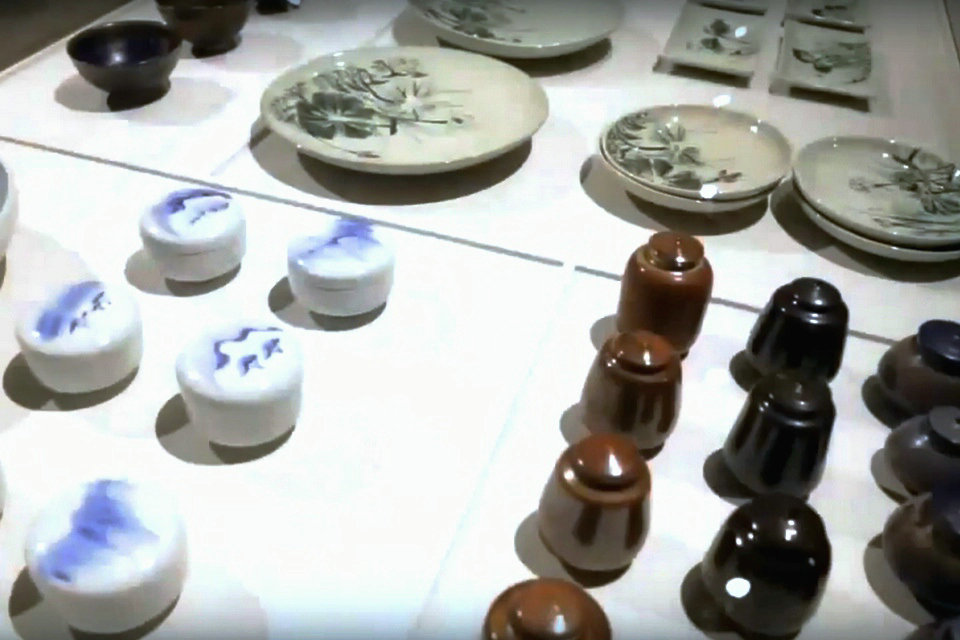Whang Chongnye Placid Dynamism, National Museum of Modern and Contemporary Art Gwacheon


Whang Chongnye Placid Dynamism is an exhibition of Korean contemporary artist series in craft department which was organized by National Museum of Modern and Contemporary Art, Korea in order to make foundation for modern art history research in Korea. This exhibition is an overall view on oeuvres of Whang Chongnye(1927~), the first generation female ceramic artist who has been connecting tradition and modernity in Korean ceramics over 60 years.
The artist discovered the color which is in contact with nature and tradition, and she experimented the color in order to handle it skillfully. She inherited the tradition not only to reproduce but to express in modern sense. In particular, traditional white slip-brushed design was transcended into expressions of spontaneous and rhythmical landscape painting arousing unexpected impressions such as coexistence of nature and human, softness and strongness. The ceramic works are full of life with scenery of nature, such as trees swaying in the wind or choppy waters, which was superimposed on the surface of static forms.
She grew up in a house of potters. Her father Whang Inchun(1894~1950) and brother Whang Jonggu(1919~2003) were pioneers in reproducing Goryeo celadon. Beyond the inheritance of family business, she combined culture and history of each era to produce ingenious contemporary ceramics. Also, generous atmospheres were created by incorporating it into everyday life.
In this exhibition, four themes which encompass Whang Chongnye’s works and her propensity were selected, and her works were rearranged to meet the “old future” for us today.
Simplicity, Permeate the color
Colors, which were found in the course of experiments in formulating various pigments, are similar to innate colors of nature. Broad spectrum of colors, from shades of dark brown to diverse hue, harmonize well with serene shape of vessels. She has been used colored glaze freely and boldly like handling paint on the canvas, and this is done in a conscious inheritance of tradition that must be transformed according to certain era.
Familiarity, Wear the nature
In the late 1970s, experiments in colored glazes lead to infatuation with slip-brushed design which has been handed down from the Joseon Dynasty. She explored the origin first, then showed off the work containing modernity on the basis of that. Brush marks without hesitation and shade of color could be reminiscent of the scene of scattered rain or undulating wind and wave. She has incorporated a sense of speed in ceramics, taking one step forward from the exploration in color, and this has been recognized as awakening of new energy and possibility in traditional Buncheong ceramics.
Vitality, Infuse the emotion
Whang Chongnye’s own world of works were created by her unremitting efforts and craftsmanship of modernistic reinterpretation of the tradition. White slip-brushed designs are transformed into wider range of colors, the works, which several brush strokes are applied on the smooth surface, became picturesque sculpture with dignity. Representation of the artist who applied the traditional Buncheong technique played a pioneering role in the modernization of Buncheong ceramics.
Fortitude, Talk about the era
Experiments in colored glaze and painterly slip-brushed design provide a variety of ways to meet our everyday life. Based on the premise that the fundamental value of craft is ‘functionality,’ she made vessels considering who uses them. She applied simply solid colored glazes, such as cobalt crystalline glaze, green glaze and red glaze, and she also drew things in nature using designs of slip-brushing, incising and stamping. Ceramics, which has its basis on tradition and reflecting the life of today, feels more familiar to the public and also has a beauty of contemporaneous sculpture.
National Museum of Contemporary Art, Gwacheon, South Korea
The National Museum of Contemporary Art, Gwacheon was designed in 1986 by architect Kim Tae-soo.
It is a family-friendly museum that harmonizes tradition and modernity by applying the Korean traditional space composition method to modern functions .
Gwacheon is a visitor-centered art museum composed of eight exhibition halls utilizing the expertise of each field such as architecture, crafts, photography, painting, sculpture, media, and children’s art museum for children’s education and experience.
You can meet the artworks of nature in the outdoor sculpture hall, and make precious memories at the National Museum of Contemporary Art, Gwacheon, where you can meet Korean modern art living in the indoor exhibition hall .